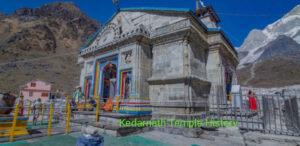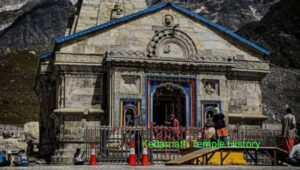Kedarnath Temple History, nestled in the majestic Himalayas, is one of the most revered pilgrimage sites in India. Dedicated to Lord Shiva, it is a part of the sacred Char Dham Yatra in Uttarakhand. This ancient temple has attracted millions of devotees from across the world, owing to its religious significance and serene surroundings. The temple’s history is deeply intertwined with ancient Indian mythology and the belief in the divine power of Lord Shiva. Kedarnath stands as a testament to the spiritual, historical, and cultural heritage of India.

1.Kedarnath Temple History: Location and Geographical Context
The Kedarnath Temple is located in the Rudraprayag district of Uttarakhand, India, at an elevation of about 3,583 meters (11,755 feet) above sea level. Surrounded by snow-capped peaks and the Mandakini River flowing by, the temple offers a breathtaking view of the mighty Kedarnath range. Due to its remote location in the Garhwal Himalayas, access to the temple is quite challenging, especially during winter months when it is covered by heavy snow.
To reach the temple, devotees typically undertake a 16 km trek from Gaurikund, though now helicopters and pony rides are available for ease of access. The temple is open to visitors from late April to early November. The extreme terrain and weather conditions make the journey difficult, but the spiritual rewards and the natural beauty make it a pilgrimage of a lifetime.
2. Kedarnath Temple History: Historical Background
The history of the Kedarnath Temple is as fascinating as the legends surrounding it. It is believed to have been originally built by the Pandavas of the Mahabharata fame as a mark of penance to seek forgiveness from Lord Shiva. The present structure, however, is said to have been reconstructed by Adi Shankaracharya in the 8th century. He established four important mathas (monastic institutions) across India, of which Kedarnath is one.
There are multiple legends connected with the origin of the temple. One popular belief states that after the Kurukshetra war, the Pandavas sought the blessings of Lord Shiva to absolve them of their sins. Shiva, however, evaded them and disguised himself as a bull. The Pandavas eventually found him in Kedarnath, where Bhima, one of the Pandava brothers, grabbed the bull by its hump. It is believed that the hump of the bull appeared at Kedarnath, while other parts of Shiva’s body appeared at various locations across the country, forming what are known as the Panch Kedar temples.

3.Architectural Features
Kedarnath Temple is a marvel of ancient Indian architecture. Built using massive stone slabs, it stands tall despite the harsh conditions of its location. The temple’s exterior walls are adorned with intricate carvings depicting Hindu deities, stories from scriptures, and various symbols associated with Lord Shiva. The style of architecture is said to reflect the skills of the builders of that era who could adapt construction techniques to suit the Himalayan region’s extreme weather.
Inside the temple, the principal deity is a conical-shaped rock that is revered as the Sadashiva form of Lord Shiva. The sanctum is simple yet profound, evoking a sense of peace and spirituality. The temple’s construction is such that it has survived multiple natural calamities, including earthquakes and floods, making it a resilient masterpiece of ancient Indian engineering.
4.Key Legends and Myths
Kedarnath is a place rich in legends and myths that elevate its spiritual significance. One of the most prominent stories is that of the Pandavas. After the great Mahabharata war, the Pandavas sought forgiveness from Lord Shiva for the sin of killing their kin. Shiva, however, did not want to forgive them so easily and disguised himself as a bull. When the Pandavas located him, Shiva tried to disappear into the ground. Bhima, the strongest of the Pandavas, managed to grab his tail and Shiva eventually forgave them. This event is believed to have occurred at Kedarnath, which is why the temple is considered a site of divine forgiveness.
Another legend ties the temple to the goddess Parvati, Shiva’s consort. It is said that Parvati meditated in the mountains near Kedarnath, adding to the region’s sanctity. Various other local folklore and spiritual tales are associated with the temple, enhancing its mythical and religious significance.
5.The Temple Through the Ages
Kedarnath Temple has witnessed centuries of devotion, natural disasters, and restoration efforts. Despite its ancient origins, the temple has managed to retain its significance through the ages, withstanding the ravages of time and nature. Several dynasties, including the Katyuri kings, were patrons of the temple, and its upkeep has been taken up by both local rulers and religious leaders over the years.
The temple has faced multiple natural calamities, yet it stands strong. It is said to have been restored by Adi Shankaracharya in the 8th century, and since then, it has undergone repairs and preservation efforts during various eras. In the modern age, both government and private organizations have taken steps to ensure the temple’s preservation for future generations.
6.The Kedarnath Disaster of 2013
In 2013, Kedarnath was hit by one of the worst natural disasters in Indian history. Flash floods triggered by a cloudburst and glacial break caused massive destruction in the region, washing away entire villages and damaging many parts of Kedarnath town. Miraculously, the Kedarnath Temple survived, standing almost unscathed amidst the wreckage, which many devotees consider a divine intervention.
Following the disaster, extensive rebuilding and restoration efforts were initiated by the government. The temple area was modernized with better infrastructure, improved accessibility, and stronger disaster management systems. The resilience of the temple continues to be a symbol of hope and faith for devotees worldwide.
7.Pilgrimage and Cultural Significance
Kedarnath is one of the four sites in the Char Dham Yatra, making it one of the most important pilgrimage destinations in Hinduism. The temple attracts thousands of devotees each year, who come seeking spiritual solace and blessings from Lord Shiva. The journey to Kedarnath is considered a penance in itself, with devotees braving the harsh terrain and weather conditions to reach the temple.
The temple also plays host to various festivals, with the most significant being Maha Shivaratri, when the entire temple is lit up and prayers continue throughout the night. Pilgrims perform rituals and offer prayers to Shiva in hopes of attaining moksha (liberation) and divine blessings.
Conclusion:
Kedarnath Temple is more than just a place of worship; it is a symbol of India’s rich spiritual and cultural history. Its location in the rugged Himalayas, combined with its mythological significance, makes it a unique and revered site. From its ancient origins and architectural splendor to its ability to withstand natural disasters, Kedarnath continues to captivate the hearts and minds of millions. For those seeking spiritual elevation, the Kedarnath Temple offers an unparalleled experience.
FAQ:
1.What is the story behind Kedarnath Temple?
2.Is Kedarnath story true?
3.How old is Kedarnath Temple?
4.What is special about Kedarnath?
5.Kedarnath real story
6.Who built Kedarnath temple
7.Kedarnath Shivling story
8.Kedarnath History wikipedia
9.Kedarnath temple inside
10.Where is Kedarnath located in which state

